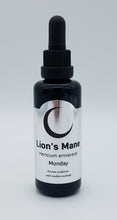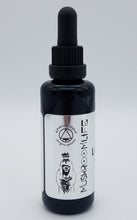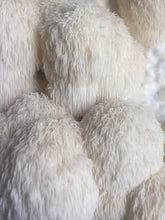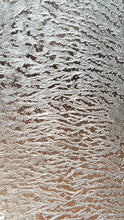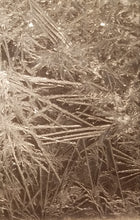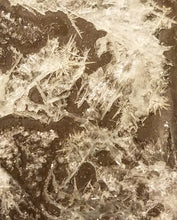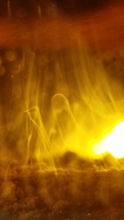
Mushroomlife’s Lion’s Mane Spagyric remains the most popular product in the company’s history. Our loyal customers appreciate the time it takes Mushroomlife associates to find this rare mushroom in the wild, and the amount of work Michael carefully and painstakingly applies to hand craft each batch, always in alchemical accordance with the lunar cycle.
Lion’s Mane mushroom, Hericium erinaceus, is a rather rare tooth fungus classified as a heart rot. This type of rot initiates itself internally, decomposing hardwood trees that are already in decline. Starting at their ‘heart’ and rotting the tree from the inside out, Lion’s Mane commonly fruits while the tree remains standing. When conditions are perfect, the Lion’s mane fruiting body will burst forth from the interior, appearing like a full moon, situated high along the outside of the trunk. Although it can fruit throughout the year, Lion’s Mane tends to prefer crisp weather conditions, for instance during the transition from autumn to winter.
This cool-weather ‘clump of dangling spines’ (Wikipedia) is rather innocuous in appearance, yet also happens to have the miraculous property of manufacturing drug-like small molecules with unique structures. In fact, Lion’s Mane mushrooms contain an exclusive set of molecules that are not known to be derived from any other living species in the natural world, whether fungus or otherwise. The two major classes of novel biomolecules in Lion’s Mane are the hericenones (aka hericerins) and the erinacines, surely a nod to the mushrooms Latin epithet Hericium erinaceus (1). Members of these unique classes of small molecules are special because they are able to cross the blood-brain barrier, a property that may be responsible for their neurologic action (2).
Extracts of H. erinaceus have been shown to stimulate the production of nerve growth factor (NGF) in vitro (3). This important property may potentially correlate with Lion’s Mane’s ability to help protect against or treat neurodegenerative disease. NGF is important in biological processes, such as controlling neuronal outgrowth and preventing cell death, which are essential in the maintenance of normal neuron functionality. Studies have revealed that the battery of uncommon chemicals contained in Lion’s Mane mushrooms may spark neurogenesis (3, 4). Laboratory studies suggest the unique chemical scaffolds extracted from the fruiting bodies of H. erinaceus may play a valuable role in the treatment and prevention of neurodegenerative diseases such as dementia, Alzheimer’s, and Parkinson’s (3). In 2019, a randomized, double-blind, placebo-controlled parallel-group comparative study was conducted in Japan, where researchers noted improvements in cognitive function after patients took supplements containing the fruiting body of H. erinaceus over 12 weeks (4). The research group concluded that intake of H. erinaceus was a safe and effective therapeutic tool to support dementia prevention (4).
Additionally, studies have shown that the battery of uncommon chemicals contained in Lion’s Mane mushrooms may further promote remyelination of nerve fibers (in vitro) (3,5). Remyelination is the process by which myelin sheaths on previously demyelinated axons in the central nervous system are regenerated. In one study, researchers tested extracts of H. erinaceus in cultivated cerebellar cells and noted that the process of myelination in the presence of the extract began earlier as compared to controls, and was characterized by a higher rate of reaction (5). During this experiment it was shown Lion’s Mane extract promotes normal cellular development and demonstrates a regulatory effect on myelin generation (5). In patients with the disease state Multiple Sclerosis (MS), over time their normal axon sheaths are stripped of their protective coating called myelin, as a consequence of auto-immune attack. Because of the potential for remyelination, Lion’s Mane extracts may be an excellent choice for individuals who have been diagnosed with MS, especially in the early stages of the disease.
Even a relatively healthy individual, over time will undergo constant wear and tear on the molecular level. Furthermore, the aging human body falls victim to an overall energetic drain resulting from the general oxidative metabolic processes incurred simply living and breathing. In addition to demyelination and neurodegeneration, the side effects of aging are manifold, and may include cognitive impairment, sleep disruption, memory issues, weakened language and decision-making skills, recall difficulties, visual perception changes, general frailty and eventual physical/mental decline. A very thorough study published in 2019 in the Journal ‘Nutrients’ concluded that two months of oral H. erinaceus supplementation in frail and aging mice improved their recognition (memory) and induced neurogenesis in both the cerebellum and hippocampus (6).
In a group of seventy-seven volunteers at the Department of Preventive Medicine, Luigi Devoto Obesity Centre in Milan Italy, eight weeks of oral H. erinaceus supplementation decreased depression, anxiety, and sleep disorders in overweight individuals (7). In this particular study, H. erinaceus supplementation improved mood disorders of a depressive-anxious nature and improved the quality of patients’ sleep (7). Results from another study conducted in Korea suggest that an extract of H. erinaceus reduces anxiety and depressive behaviors in adult mice (8). Researchers tracked certain biomarkers before and after administration of the extract and concluded the anti-anxiety and anti-depressive effects seen are potentially occurring via the promotion of cerebral neurogenesis in the hippocampus (8).
To make our Lion’s Mane Spagyric, only the most select wild mushrooms were harvested from their natural habitat. In the wild, each fruiting body mounts robust chemical defenses against many other organisms in order to fruit and survive. Studies show wild mushrooms have up to 30x more secondary metabolite production than their cultivated counterparts (9). These ‘secondary metabolites’ are biomolecules generated by the mushroom to protect itself in nature. These biologically active molecules are recognized by the human body, and used to the same end, to help regulate immune function and protect from foreign invaders.
In alchemy, the Lion’s Mane mushroom is a representation of Monday, the day of the week that correlates with the moon. All around the world, in many different languages from ancient Greek and Latin, to present day Norwegian, English, Chinese and Japanese, the word for Monday honors the moon. The moon has a stabilizing effect on Earth’s climate, and without it the gravitational perturbations from larger planets would disturb Earth’s tilt. Without the moon the Earth would be uninhabitable, just as without the brain the human body would be unable to function properly.
We truly believe our process of mushroom spagyric creation is special, including the painstaking attention to detail and high level of discipline that is required. It takes a lot of time, financial resource, and physical work to produce a single batch of spagyric extract. The level of dedication within those selflessly practicing these arts is a beautiful thing to behold. The spagyric process is rooted in some of the oldest forms of transmutation practiced by mankind. The people who see the purpose behind this type of slow medicine are as special as the spagyrics themselves. With a keen eye on the mind, the stars, and the flask we forge on in faith of obtaining a greater wellness through these operations. For a brief description what a spagyric is, how we make ours, and why, please see our 'Spagyrics' tab.
These statements have not been evaluated by the Food and Drug Administration. This product is not intended to diagnose, treat, cure or prevent any disease.
1. Friedman M. “Chemistry, Nutrition, and Health-Promoting Properties of Hericium erinaceus (Lion’s Mane) Mushroom Fruiting Bodies and Mycelia and Their Bioactive Compounds.” Journal of Agricultural and Food Chemistry. 2015, 63(32): 7108-7123.
2. Crespo-Bujosa HB, Suárez Rodríguez RLF. “Nootropics: Phytochemicals with Neuroprotective and Neurocognitive Enhancing Properties.” European Journal of Clinical and Experimental Medicine. 2019, 17 (3): 250–255.
3. Ma BJ, Shen JW, Yu H, Ruan Y, Wu T, Zhao X. “Hericenones and erinacines: stimulators of nerve growth factor (NGF) biosynthesis in Hericium erinaceus.” Mycology. 2010, 1:2, 92-98.
4. Saitsu Y, Nishide A, Kikushima K, Shimizu K, Ohnuki K. “Improvement of cognitive functions by oral intake of Hericium erinaceus.” Biomedical Research. 2019, 40(4): 125-131.
5. Kolotushkina EV, Moldavan MG, Voronin Y, Skibo GG. “The influence of Hericium erinaceus extract on myelination process in vitro.” Russian Physiology Journal. 2003, 49(1): 38-45.
6. Ratto D, Corana F, Mannucci B, Priori EC, Cobelli F, Roda E, Ferrari B, Occhinegro A, Di Iorio C, De Luca F, Cesaroni V, Girometta C, Bottone MG, Savino E, Kawagishi H, Rossi P. “Hericium erinaceus Improves Recognition Memory and Induces Hippocampal and Cerebellar Neurogenesis in Frail Mice during Aging.” Nutrients. 2019, 11, 715.
7. Vigna L, Morelli F, Agnelli GM, Napolitano F, Ratto D, Occhinegro A, Di Iorio C, Savino E, Girometta C, Brandalise F, Rossi P. “Hericium erinaceus Improves Mood and Sleep Disorders in Patients Affected by Overweight or Obesity: Could Circulating Pro-BDNF and BDNF Be Potential Biomarkers?” Evidence-Based Complementary and Alternative Medicine. 2019, Article ID 7861297.
8. Ryu S, Kim HG, Kim JY, Kim SY, Cho KO. “Hericium erinaceus Extract Reduces Anxiety and Depressive Behaviors by Promoting Hippocampal Neurogenesis in the Adult Mouse Brain.” Journal of Medicinal Food. 2018, 21(2): 174-180.
9. Hobbs, C. Medicinal Mushrooms: An Exploration of Tradition, Healing and Culture. Santa Cruz, CA: Botanica Press. 1996.







